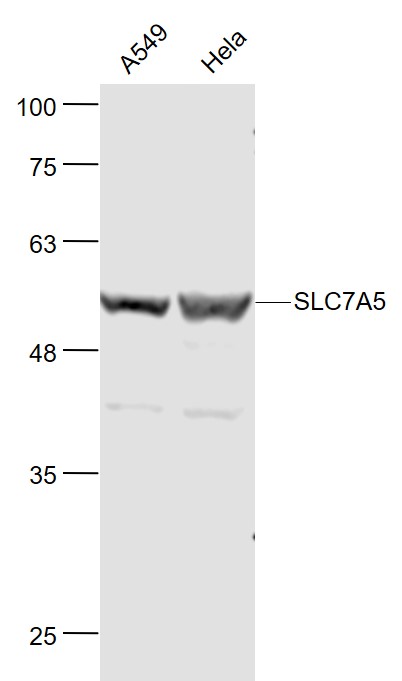SLC7A5 Rabbit pAb
SLC7A5 Rabbit pAb
- 产品详情
- 实验流程
- 背景知识
Application
| WB |
|---|---|
| Reactivity | Mouse |
| Host | Rabbit |
| Clonality | Polyclonal |
| Calculated MW | 55 KDa |
| Physical State | Liquid |
| Immunogen | KLH conjugated synthetic peptide derived from mouse SLC7A5 |
| Epitope Specificity | 1-100/512 |
| Isotype | IgG |
| Purity | affinity purified by Protein A |
| Buffer | 0.01M TBS (pH7.4) with 1% BSA, 0.02% Proclin300 and 50% Glycerol. |
| SUBCELLULAR LOCATION | Cytoplasm, cytosol. Apical cell membrane. Located to the plasma membrane by SLC3A2/4F2hc. Localized to the apical membrane of placental syncytiophoblastic cells. Expressed in both luminal and abluminal membranes of brain capillary endothelial cells. |
| SIMILARITY | Belongs to the amino acid-polyamine-organocation (APC) superfamily. L-type amino acid transporter (LAT) (TC 2.A.3.8) family. |
| Important Note | This product as supplied is intended for research use only, not for use in human, therapeutic or diagnostic applications. |
| Background Descriptions | L-type amino acid transporter 1 (LAT1) is a multipass-membrane protein responsible for sodium-independent, high-affinity transport of large neutral amino acids. LAT1 functions as a disulfide-linked heterodimer with the amino acid transport protein CD98. LAT1 is expressed predominantly in adult lung and liver but is also expressed in brain, thymus, retina, testis, placenta, bone marrow and fetal liver. In the retina, LAT1 localizes to the blood-retinal-barrier (BRB) and mediates L-leucine transport from the blood to the retina. The devastating effects on the brain caused by phenylketonuria are due to the increased levels of LAT1 on the blood-brain-barrier in response to high concentrations of phenylalanine in the blood. LAT1 accepts the amino-acid related anticancer agent melphalan and plays a significant role in cell proliferation, differentiation, and invasion in esophageal squamous cell carcinoma. |
| Target/Specificity | Expressed abundantly in adult lung, liver, brain, skeletal muscle, placenta, bone marrow, testis, resting lymphocytes and monocytes, and in fetal liver. Weaker expression in thymus, cornea, retina, peripheral leukocytes, spleen, kidney, colon and lymph node. During gestation, expression in the placenta was significantly stronger at full-term than at the mid-trimester stage. Also expressed in all human tumor cell lines tested and in the astrocytic process of primary astrocytic gliomas. Expressed in retinal endothelial cells and in the intestinal epithelial cell line Caco-2. |
|---|---|
| Dilution | WB=1:500-2000 |
| Format | 0.01M TBS(pH7.4) with 1% BSA, 0.09% (W/V) sodium azide and 50% Glyce |
| Storage | Store at -20 °C for one year. Avoid repeated freeze/thaw cycles. When reconstituted in sterile pH 7.4 0.01M PBS or diluent of antibody the antibody is stable for at least two weeks at 2-4 °C. |
Research Areas
For Research Use Only. Not For Use In Diagnostic Procedures.
Application Protocols
Provided below are standard protocols that you may find useful for product applications.
BACKGROUND
This product as supplied is intended for research use only, not for use in human, therapeutic or diagnostic applications.
终于等到您。ABCEPTA(百远生物)抗体产品。
点击下方“我要评价 ”按钮提交您的反馈信息,您的反馈和评价是我们最宝贵的财富之一,
我们将在1-3个工作日内处理您的反馈信息。
如有疑问,联系:0512-88856768 tech-china@abcepta.com.























 癌症的基本特征包括细胞增殖、血管生成、迁移、凋亡逃避机制和细胞永生等。找到癌症发生过程中这些通路的关键标记物和对应的抗体用于检测至关重要。
癌症的基本特征包括细胞增殖、血管生成、迁移、凋亡逃避机制和细胞永生等。找到癌症发生过程中这些通路的关键标记物和对应的抗体用于检测至关重要。 为您推荐一个泛素化位点预测神器——泛素化分析工具,可以为您的蛋白的泛素化位点作出预测和评分。
为您推荐一个泛素化位点预测神器——泛素化分析工具,可以为您的蛋白的泛素化位点作出预测和评分。 细胞自噬受体图形绘图工具为你的蛋白的细胞受体结合位点作出预测和评分,识别结合到自噬通路中的蛋白是非常重要的,便于让我们理解自噬在正常生理、病理过程中的作用,如发育、细胞分化、神经退化性疾病、压力条件下、感染和癌症。
细胞自噬受体图形绘图工具为你的蛋白的细胞受体结合位点作出预测和评分,识别结合到自噬通路中的蛋白是非常重要的,便于让我们理解自噬在正常生理、病理过程中的作用,如发育、细胞分化、神经退化性疾病、压力条件下、感染和癌症。






